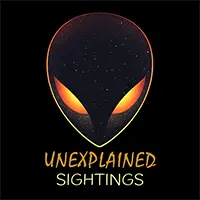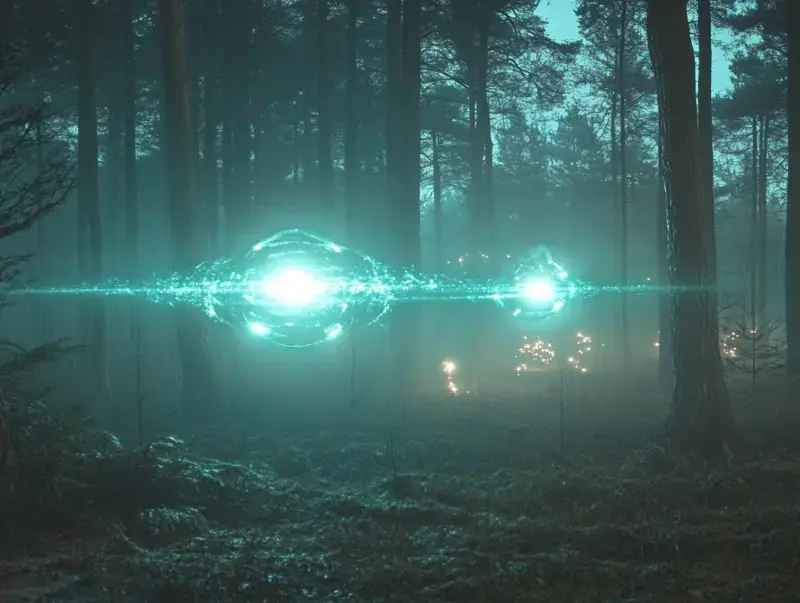Introduction: A Night of Unexplainable Lights
Picture this: a cold December night in 1980. The air is still, and the dense trees of Rendlesham Forest stand silent like ancient sentinels. Suddenly, strange lights cut through the darkness—bobbing, weaving, and defying all logic. For the U.S. Air Force personnel stationed at RAF Woodbridge, it was supposed to be a routine night. What they encountered instead would go down in history as “The Rendlesham Forest Incident”—a mystery so perplexing it’s often dubbed the “British Roswell”.
Was it a case of mistaken identity involving a lighthouse beam, as skeptics claim? Or was it an extraterrestrial craft testing the waters of human contact? Some witnesses reported seeing a Rendlesham Forest UFO, while others described eerie symbols on the hull of an unknown object. Even stranger, some say their equipment—almost like a high-tech version of an anomaly alien detector radar—went haywire in the presence of the lights.
Among the key witnesses was John Burroughs, whose account of the Rendlesham UFO sighting sparked decades of debates, books, and documentaries. Not to mention the infamous Nick Pope, a former Ministry of Defence official who would later investigate the event and become one of its most vocal advocates.
But was this an isolated incident? Hardly. Around the same time, other strange sightings made headlines—the Belgian UFO wave across Europe and the Phoenix Lights Incident in the United States. Could all these sightings be connected? And if so, why does the truth remain just out of reach, like a faint glimmer of light between the trees?
Grab your flashlight and follow the Rendlesham Forest UFO trail—this story is about to get even weirder.
Chapter 1: The Night It All Began – December 1980
If there’s one thing that can shatter the peace of a Suffolk night, it’s an unexpected visitor—especially one that doesn’t come knocking on the door. The Rendlesham Forest Incident began just after midnight on December 26, 1980. Nestled between RAF Woodbridge and RAF Bentwaters, two airbases used by the United States Air Force during the Cold War, Rendlesham Forest became the stage for one of the most infamous military UFO encounters ever recorded.It started with a report of strange lights descending into the forest. At first, security personnel thought it might be a downed aircraft, so a team was sent to investigate. What they found, however, was no ordinary crash site. According to eyewitness accounts, they stumbled upon a metallic, triangular-shaped craft hovering just above the forest floor. Its surface appeared smooth, marked with symbols that one witness, John Burroughs, later compared to hieroglyphics. The air crackled with static electricity, and nearby animals—both wild and domestic—reacted in panic, adding to the eerie atmosphere of the Rendlesham UFO incident.
The team reported that their radios malfunctioned as they approached the object, as if some invisible force was interfering with their equipment—an encounter that might have warranted the use of an anomaly alien detector radar, had such technology existed outside of science fiction. Despite their best efforts, the craft suddenly lifted off and vanished into the night sky at an impossible speed, leaving behind scorched marks on the ground and broken branches in its wake.
Over the next two nights, sightings continued, with different personnel reporting encounters with strange lights and unexplained phenomena. One of the most notable witnesses was Lieutenant Colonel Charles Halt, the deputy base commander, who led an investigation into the forest equipped with a Geiger counter, which detected unusually high radiation levels at the site. Halt later documented his experience in what became known as the Halt Memo, a key piece of evidence that cemented the incident’s place in UFO history.
While skeptics would later argue that the lights were nothing more than the nearby Orford Ness lighthouse or reflections from military vehicles, those who were there tell a different story. To this day, the Rendlesham Forest UFO sighting remains one of the most well-documented and hotly debated encounters of its kind.
But what did these witnesses actually see? A craft from another world? A top-secret military experiment? Or something else entirely? As we dig deeper into the personal testimonies of those who were there, the line between fact and fiction becomes increasingly blurred.
Chapter 2: Eyewitness Accounts – The Truth in Their Own Words
They say seeing is believing, but when it comes to the Rendlesham Forest Incident, seeing seemed to lead only to more questions. The airmen stationed at RAF Woodbridge and RAF Bentwaters weren’t just bystanders—they were participants in a mystery that continues to captivate UFO enthusiasts and skeptics alike. What follows are their stories, each adding another layer of intrigue to the Rendlesham UFO incident.
John Burroughs: The Man Who Touched the Unknown
Imagine walking through the dark woods, the air thick with static, and coming face-to-face with a craft unlike anything built by human hands. That’s exactly what John Burroughs claims happened to him that night in December 1980. Burroughs, a young U.S. Air Force officer, described seeing a triangular-shaped object with strange symbols etched into its hull—a design that seemed more at home in a science fiction novel than in the quiet woods of Suffolk.
As he approached the craft, Burroughs experienced a strange sensation, as if time itself had warped. Some believe he may have been exposed to an electromagnetic field generated by the object, a theory bolstered by later health issues that he attributed to the encounter. Despite the skeptics’ claims of misidentified aircraft or the nearby Orford Ness lighthouse, Burroughs remains convinced that what he witnessed was neither man-made nor terrestrial.
“I know what I saw,” Burroughs has repeatedly stated, a phrase that has become synonymous with UFO encounters worldwide.
Jim Penniston: A Close Encounter and a Code from Beyond
If Burroughs’ account wasn’t strange enough, then Jim Penniston’s experience takes the encounter to a whole new level of bizarre. Also present during the first night of sightings, Penniston approached the object closely enough to touch its smooth, metallic surface. Decades later, Penniston revealed that upon touching the craft, he received what he described as a telepathic download of binary code—a sequence of ones and zeros that haunted his mind until he recorded them in his notebook.
When decoded years later, the binary code allegedly contained coordinates pointing to ancient sites like Stonehenge and the pyramids of Giza, as well as a cryptic message referencing “exploration of humanity.” Whether this is evidence of extraterrestrial communication or simply the result of an overactive imagination remains a point of contention, but it certainly adds to the air of mystery that surrounds the Rendlesham Forest UFO sighting.
Charles Halt: The Officer Who Documented the Unexplainable
While many UFO sightings rely solely on eyewitness testimony, the Rendlesham Forest Incident stands out for its tangible documentation. Leading the investigation on the second night was Lieutenant Colonel Charles Halt, the deputy base commander of RAF Bentwaters. Armed with a Geiger counter and a tape recorder, Halt ventured into the woods determined to find a rational explanation. What he found instead would become the stuff of legend.
As Halt and his team moved through the forest, they observed strange lights weaving through the trees—pulsing, shifting, and sometimes splitting into multiple orbs. At one point, a red light hovered above a nearby field, appearing to shed molten metal before silently disappearing into the night sky. All the while, Halt’s Geiger counter registered radiation levels far above the normal background levels, adding a layer of physical evidence to the otherwise surreal encounter.
Halt’s audio recording, made in real time as the events unfolded, remains one of the most compelling pieces of evidence associated with the case. In the recording, Halt’s voice can be heard describing the lights and the team’s attempts to follow them, capturing both the awe and frustration of chasing something that seemed always just out of reach.
“I don’t think we’re alone,” Halt would later state in interviews, standing by his belief that what they witnessed was not of this Earth.
Other Witnesses: Lights, Shadows, and Silent Craft
While Burroughs, Penniston, and Halt are the most well-known figures connected to the Rendlesham UFO sighting, they were far from the only witnesses. Over the course of three nights, dozens of military personnel reported seeing lights and unusual craft in and around the forest. Some described beams of light descending from the sky and illuminating the ground, while others reported shadows moving through the trees with unnatural speed.
The sheer number of witnesses, combined with their military training and credibility, makes the Rendlesham Forest UFO incident difficult to dismiss as mere hallucination or misidentification. Yet, despite their detailed accounts, official explanations continued to focus on more mundane possibilities, such as aircraft navigation lights or the Orford Ness lighthouse.
But for those who were there, the memory of that cold December night remains as vivid as ever—a reminder that sometimes, the truth is stranger than fiction.

